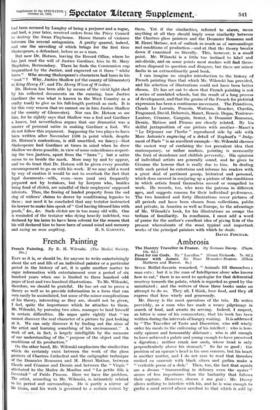French Painting
EASY as it is, or should-be, for anyone to write entertainingly about the art and life of an individual painter or a particular period in the history of art, it is quite another- matter to sugar information with entertainment over a period of six hundred years when one is limited to three hundred odd pages of text and two hundred illustrations. To Mr. Wilenski, therefore, we should be grateful. He has set out to prove a theory as well as to provide information in a form that can very easily be assimilated, but some of the minor complications of his theory, interesting as they are, should not be given, I feel, quite the importance which he attaches to them. Mr. Wilenski, by pursuing two aims, manages to land himself in certain difficulties. He urges quite rightly that " we cannot discover the real character of a picture by just looking at it. We can only discover it by finding out the aims of the artist and learning something of his environment." A work of art, in fact, is largely intelligible by the measure of our understanding of the " purpose of the object and the conditions of its production."
On the other hand, Mr. Wilenski emphasizes the similarities which do certainly exist between the work of the glass painters of .Chartres Cathedral and the caligraphic technique of the Douanier Rousseau and M. Henri Matisse, between Claude and Cezanne and Derain and between the " Virgin " attributed to the Maitre de Moulins and " La petite fille reventail " of Pablo Picasso. Here we have the problem. The artist, according to Mr. Wilenski, is intimately related to his period and surroundings. He is partly a mirror of his times, and his work is governed to a certain extent by them. Yet if the similarities, referred to above, mean anything at all they should imply some similarity between the Chartres glass painters and the Douanier Rousseau and M. Henri Matisse, not of outlook so much as of surroundings and conditions of production—and at that the theory breaks down if examined oo literally. This, however, is a small point. Mr. Wilenski is a little too inclined to label and sub-divide, and on some points most readers will find them- selves disposed to question and disagree, but these are minor faults in an extraordinarily good book.
I can imagine no simpler introduction to the history of French painting than that which Mr. Wilenski has provided, and his selection of illustrations could not have been better chosen. He has set out to show that French painting is not a series of unrelated schools, but the result of a long process of development, and that the genius of the French for pictorial expression has been a continuous movement. The Primitives, Claude Le Lorrain, Poussin, Watteau, Boucher, Chardin, Fragonard, David, Delacroix, Manet, Renoir, Degas, Toulouse- Lautrec, Menne, Gauguin, Seurat, le Douanier Rousseau, Derain, Matisse and Picasso are closely related. By his skilful juxtaposition of one picture with another—Manet's " Le Dejeuner sur l'herbe " reproduced side by side with Marc Antonio's engraving of a detail of Raphael's " Judg- ment of Paris " is an excellent example—Mr. Wilensid chooses the easiest way of confuting the too prevalent idea that contemporary, or rather modern, painting is necessarily the fruit of decadence and childish perversity. His opinions of individual artists are generally sound, and he gives to Cizanne the honour that is really due to him. In dealing, with each period he entertains and informs his readers with a great deal of pertinent gossip, historical and personal, which does succeed in conjuring up a picture of the conditions in which artists found themselves moved or compelled to work. He records, too, who were the patrons in different ages, and suggests reasons for their individual preferences. The two hundred and forty illustrations cover pictures of all periods and have been chosen from collections, public and private, in America as well as Europe, to the advantage of Mr. Wilenski's book, for his illustrations so escape the tedium of familiarity. In conclusion, I must add a word of praise for the author's excellent idea of giving lists of the present whereabouts of the most typical and important; works of the principal painters with which he deals.
DAVID FINCIIAM,














































 Previous page
Previous page